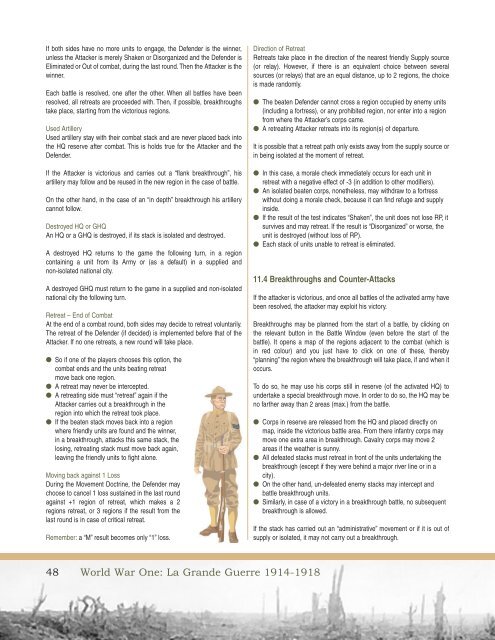Create successful ePaper yourself
Turn your PDF publications into a flip-book with our unique Google optimized e-Paper software.
If both sides have no more units to engage, the Defender is the winner,<br />
unless the Attacker is merely Shaken or Disorganized and the Defender is<br />
Eliminated or Out of combat, during the last round. Then the Attacker is the<br />
winner.<br />
Each battle is resolved, one after the other. When all battles have been<br />
resolved, all retreats are proceeded with. Then, if possible, breakthroughs<br />
take place, starting from the victorious regions.<br />
Used Artillery<br />
Used artillery stay with their combat stack and are never placed back into<br />
the HQ reserve after combat. This is holds true for the Attacker and the<br />
Defender.<br />
If the Attacker is victorious and carries out a “flank breakthrough”, his<br />
artillery may follow and be reused in the new region in the case of battle.<br />
On the other hand, in the case of an “in depth” breakthrough his artillery<br />
cannot follow.<br />
Destroyed HQ or GHQ<br />
An HQ or a GHQ is destroyed, if its stack is isolated and destroyed.<br />
A destroyed HQ returns to the game the following turn, in a region<br />
containing a unit from its Army or (as a default) in a supplied and<br />
non-isolated national city.<br />
A destroyed GHQ must return to the game in a supplied and non-isolated<br />
national city the following turn.<br />
Retreat – End of Combat<br />
At the end of a combat round, both sides may decide to retreat voluntarily.<br />
The retreat of the Defender (if decided) is implemented before that of the<br />
Attacker. If no one retreats, a new round will take place.<br />
● So if one of the players chooses this option, the<br />
combat ends and the units beating retreat<br />
move back one region.<br />
● A retreat may never be intercepted.<br />
● A retreating side must “retreat” again if the<br />
Attacker carries out a breakthrough in the<br />
region into which the retreat took place.<br />
● If the beaten stack moves back into a region<br />
where friendly units are found and the winner,<br />
in a breakthrough, attacks this same stack, the<br />
losing, retreating stack must move back again,<br />
leaving the friendly units to fight alone.<br />
Moving back against 1 Loss<br />
During the Movement Doctrine, the Defender may<br />
choose to cancel 1 loss sustained in the last round<br />
against +1 region of retreat, which makes a 2<br />
regions retreat, or 3 regions if the result from the<br />
last round is in case of critical retreat.<br />
Remember: a “M” result becomes only “1” loss.<br />
48 World War One: La Grande Guerre 1914-1918<br />
Direction of Retreat<br />
Retreats take place in the direction of the nearest friendly Supply source<br />
(or relay). However, if there is an equivalent choice between several<br />
sources (or relays) that are an equal distance, up to 2 regions, the choice<br />
is made randomly.<br />
● The beaten Defender cannot cross a region occupied by enemy units<br />
(including a fortress), or any prohibited region, nor enter into a region<br />
from where the Attacker’s corps came.<br />
● A retreating Attacker retreats into its region(s) of departure.<br />
It is possible that a retreat path only exists away from the supply source or<br />
in being isolated at the moment of retreat.<br />
● In this case, a morale check immediately occurs for each unit in<br />
retreat with a negative effect of -3 (in addition to other modifiers).<br />
● An isolated beaten corps, nonetheless, may withdraw to a fortress<br />
without doing a morale check, because it can find refuge and supply<br />
inside.<br />
● If the result of the test indicates “Shaken”, the unit does not lose RP, it<br />
survives and may retreat. If the result is “Disorganized” or worse, the<br />
unit is destroyed (without loss of RP).<br />
● Each stack of units unable to retreat is eliminated.<br />
11.4 Breakthroughs and Counter-Attacks<br />
If the attacker is victorious, and once all battles of the activated army have<br />
been resolved, the attacker may exploit his victory.<br />
Breakthroughs may be planned from the start of a battle, by clicking on<br />
the relevant button in the Battle Window (even before the start of the<br />
battle). It opens a map of the regions adjacent to the combat (which is<br />
in red colour) and you just have to click on one of these, thereby<br />
“planning” the region where the breakthrough will take place, if and when it<br />
occurs.<br />
To do so, he may use his corps still in reserve (of the activated HQ) to<br />
undertake a special breakthrough move. In order to do so, the HQ may be<br />
no farther away than 2 areas (max.) from the battle.<br />
● Corps in reserve are released from the HQ and placed directly on<br />
map, inside the victorious battle area. From there infantry corps may<br />
move one extra area in breakthrough. Cavalry corps may move 2<br />
areas if the weather is sunny.<br />
● All defeated stacks must retreat in front of the units undertaking the<br />
breakthrough (except if they were behind a major river line or in a<br />
city).<br />
● On the other hand, un-defeated enemy stacks may intercept and<br />
battle breakthrough units.<br />
● Similarly, in case of a victory in a breakthrough battle, no subsequent<br />
breakthrough is allowed.<br />
If the stack has carried out an “administrative” movement or if it is out of<br />
supply or isolated, it may not carry out a breakthrough.
















